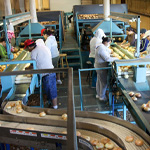Farm to Table
A RealSweet® Story
All of the products grown on our farms are non-GMO, grown using either organic or conventional farming practices perfected over years — and generations — of experience. We'd like to take you through the process of how we grow, harvest, package and ship our Vidalia onions. Please join us where it all begins in the field.

Our Vidalia onion fields are prepared for planting in early September — just after that season’s last Vidalias are shipped. A tractor tills the soil and builds a raised bed where the onion seeds will be planted.

Vidalia sweet onion seeds, just before they're planted. These seeds can be planted anywhere, but to grow a Vidalia sweet onion, they must be planted within the 20-county growing region in Southeast Georgia.

Vidalia onion seeds are dropped by specialized planting equipment into the prepared soil. They must be planted at a specific depth and during good weather to ensure they are not washed away.

The first Vidalia onion seedlings are seen breaking through the soil in mid to late September. Vidalias are “short day” onions, or onion plants that grow during the months of fewer daylight hours.

A Vidalia plant after around 30 days of growth is slightly smaller than a pencil. A full-size onion bulb can reach the size of a softball. Vidalias are shipped in multiple sizes, including medium, jumbo & colossal.

The tops of the Vidalia sweet onions are trimmed back as they are prepared for the transplanting process. Onion plants that are transplanted into new fields are less likely to be affected by common plant diseases.

Vidalia sweet onion plants are carefully pulled from the ground, bundled and taken to a new field where they will complete their growth. These plants are about the size of green onions found in the produce aisle.

A tractor and specialized machinery is used to punch holes in the transplant fields to prepare a new home for Vidalia sweet onion plants and their next stage of growth as the onions are allowed to bulb.

Each Vidalia sweet onion plant is carefully placed in its new home, approximately 4 ½ to 6 inches apart. Over the next four months, the plant will grow to its full size before the harvest in mid to late April.

Vidalia sweet onion plants are transplanted into their new home in November and December to allow the plants more room to grow and keep them protected from cold weather and disease.

A Vidalia onion bulb breaks through the surface of the sandy Georgia soil. In about 6 - 9 weeks, this onion will be ready for harvest. It’s the sandy loam soils in the region that help to create the sweet flavor.

In a few short weeks, these onions will be ready for use in your favorite recipes. The tops of the onion plants stand taller as the day goes on, reaching for the sky as the sun gets higher in the afternoon.

Nearly ready to eat, these Vidalias are only days away from full maturity. As the onions reach their peak, the green tops will begin to lay down and signify that they are ready to be harvested.

At harvest time, Vidalia sweet onion plants are undercut by a tractor to pull them from the soil and onto the surface of the field. From this point on, all of the work will be done entirely by hand.

Our Vidalias dry naturally in the Georgia sun for several days before they’re brought into our packing facilities. Average temperatures in the 70’s combined with a light breeze make for ideal drying conditions.

Each Vidalia sweet onion is clipped by hand and placed into drying bins. This process is done carefully and by hand because a Vidalia onion's high water content allows it to bruise easily.

While the necks and roots of the onions dry in the field, Vidalias will cure for 24 to 48 hours in our state-of-the-art drying rooms at 95 degrees. This helps to keep them fresh in the produce aisle and your pantry.

Our Vidalia sweet onions are sized and graded when they’re brought into the packing and storage facility and then again before they are packaged to be sure only the best Vidalia sweet onions are shipped.

Our Vidalias are packed by specific sizes and weights into the RealSweet® bags and cartons you’ll see at your local grocery store. Each bag is checked by hand for quality and weight accuracy before shipping.

Once packaged, our sweet onions are loaded onto trucks and shipped to your local grocer. The Vidalia growing region may only be in Southeast GA, but our Vidalias are available all over the country.
